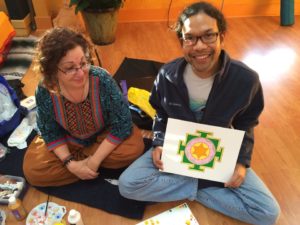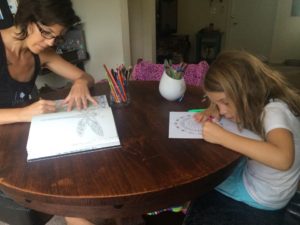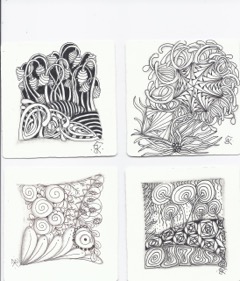Leaving the left brain with meditative art
By Nancy B. Loughlin
Published in News Press on June 2, 2015
There are two sides to every brain, at least metaphorically.
People don’t use one side of the brain more than the other, yet the language is apt for explaining two different personality types. Those who like to describe themselves as “left-brained” tend to favor processes that are logical and sequential. Left brain is the stuff of linear reasoning and mathematical calculations. “Right-brained” people are more holistic in their perspectives, and they align with creativity and intuition.
Balance is ideal. Facts and logic should be tempered by feeling while intuition is sharpened and tested by the academic touch.
Unfortunately, such balance is difficult in a left brain-dominant environment. Nowhere is this clearer than in public education where the arts are easily sacrificed in favor of regimented approaches to standardized test preparation and multiple-choice questions.
Meditative art and drawing can offer much needed “right-brain” stimulation.
Brian Bomeisler, lead instructor for Drawing on the Right Side of the Brain, suggested in a telephone interview that drawing offers more than a tangible art product. It’s an opportunity for new perspectives.
He explained the right-brain drawing method is about sensing new relationships: differentiating between light and shadows, noting edges and connections and even negative space. This approach was popularized by Bomeisler’s mother, Betty Edwards, in her bestselling book “Drawing on the Right Side of the Brain.”
“I teach people how to see the world differently,” Bomeisler said. Visit his website: www.DrawRight.com.
Try three meditative arts:
Coloring. Ani St. Onge, age 5 in Fort Myers, does not color alone. Her mother is by her side.
“She gets calm, chill. And she’s focused when she colors,” yoga teacher Aja Reeser said of her daughter.
“The coloring holds her attention to the present and makes use of fine motor skills, creativity, eye-hand coordination and creative decision-making,” she said.
And in “small doses and sneaky ways,” Reeser is imparting the practice of yoga at the same time.
She explained the coloring and its repetitive motion evoke mindfulness, and that is a powerful pre-meditation skill.
This is, indeed, “dharana,” the concentration that results from being free of distraction.
For 15-minute stretches, mother and daughter sit at the kitchen table for this creative quality time. Reeser, an art student in college, engages her coloring practice with “The Enchanted Forest,” the exquisite and bestselling coloring book created for adults by Johanna Basford.
Meanwhile, little Ani creates color patterns in mandalas, sacred circles that represent unity and wholeness.
Visit www.PrintMandala.com or www.ColorMandala.com for free, downloadable images for coloring.
Zentangles.
A sadhana is a daily ritual used to Know Thyself. Author and artist Beckah Krahula suggests a Zentangle each day for six weeks as a meditative tool.
According to Krahula, a Zentangle begins on a 3.5 x 3.5-inch tile. Draw four dots in the corners and connect them for a border, and create a “string” inside that square to break it into sections. Then, fill each section with repetitive patterns.
“It’s the repetitive patterns that slide the brain into that higher state of focus,” Krahula said in a telephone interview.
And no experience is necessary. All you need is paper, a pen and a pencil.
She explained that with Zentangles, there are no plans or erasers. When you place your pen or pencil to the pattern, the intention is focused on the stroke you create in that moment and not how the image is going to look when you are finished.
How yogic.
“As we age and our days get longer, we can lose that sharpness. The Zentangle is an opportunity to regroup and reset the brain. This ten-minute break is the equivalent of a two-hour nap,” she said.
For more information on Zentangles, check out Beckah Krahula’s terrific book “One Zentangle a Day” and visit her website: www.BeckahKrahula.com.
Yantras. A Yantra, according to artist and educator Mavis Gewant, is a geometric centering tool that usually represents deities, goddesses or the planets.
Gewant recently led a two-day Yantra workshop at Love Yoga, Naples.
Gewant works with five goddesses: Kali, Lakshmi, Durga, Saraswati and Gayatri. Once students choose which goddesses resonate most, Gewant leads them in the process of creating the meticulous geometric pattern and then filling it with color.
Throughout the Yantra creation, the student chants the mantra of that goddess.
“The act of creating the Yantra demands that the student remains one-focused, calming the left brain. The Yantra opens your creativity so you can be more in touch with your emotional nature, heart and intuition,” Gewant said.
And that’s very right.
Visit Mavis Gewant’s website: www.sacredmotherarts.com.



